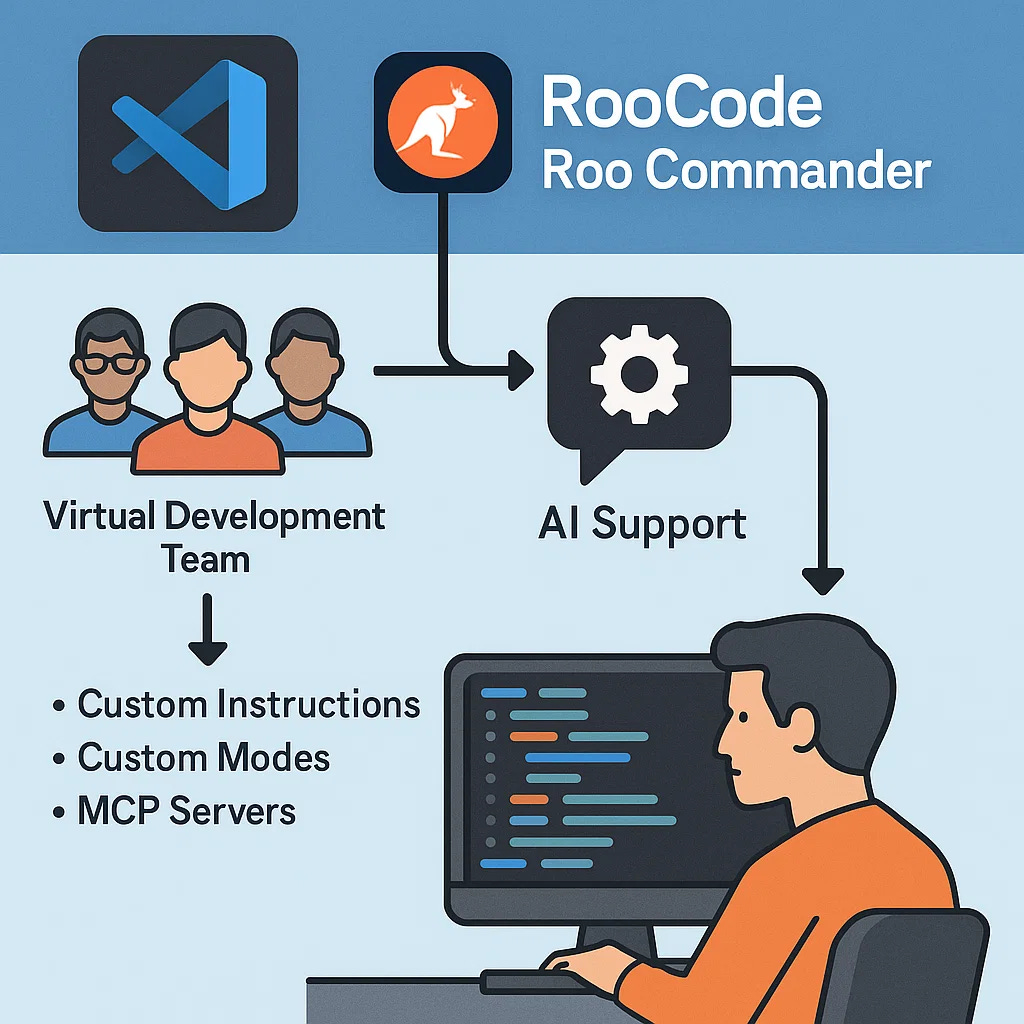Beyond Context Engineering: Systemically Scaling AI-Augmented Development Teams
With RooCode and Roo Commander in VSCode
The software industry stands at an inflection point. We've moved from simple code completion to context-aware development environments, from individual productivity tools to systems that encode entire team philosophies. This evolution presents an opportunity to fundamentally change how we approach team productivity and code quality, moving beyond individual compliance to systematically enforced best practices.
The shift from "vibe coding" to context engineering, which I explored last week, revealed something profound: we're not just augmenting developers with faster typing—we're creating systems that can enforce Quality Management Systems (QMS) at the point of creation. This isn't about replacing human judgment; it's about codifying decades of hard-won engineering wisdom into tools that make excellence the path of least resistance.
The Virtual Development Team: Your Senior Engineers, Amplified
What I've discovered in RooCode and Roo Commander goes beyond typical AI assistance. Through RooCode’s Custom Instructions and Custom Modes, we're essentially creating a virtual development team shaped by our senior engineers' expertise. This virtual team doesn't sleep, doesn't forget conventions, and consistently applies architectural patterns across every line of code.
Consider the traditional challenge: you have three senior engineers who understand your system's intricacies, ten mid-level developers who mostly get it, and a rotating cast of juniors learning the ropes. Knowledge transfer happens through code reviews, documentation, and osmosis—all lossy, time-consuming processes.
Custom Instructions in RooCode change this dynamic entirely. Your senior engineers encode their decision-making directly into the development environment. When they specify "always use circuit breakers for external service calls" or "implement correlation IDs for distributed tracing," these aren't just guidelines in a wiki—they become active participants in code generation.
The technical implementation is elegant. Custom Instructions operate at the prompt level, injecting context before any generation begins. They're essentially prompt engineering templates that ensure every interaction starts with your team's accumulated wisdom. Think of them as your most experienced developer whispering best practices in every developer's ear, every time they code.
Custom Modes: From Guidelines to Guardrails
While Custom Instructions set the stage, Custom Modes in RooCode transform suggestions into systematic enforcement. This is where the virtual development team concept truly shines.
A Custom Mode isn't just a template—it's a complete development persona. When I create a "Microservice Mode," I'm not just defining code patterns. I'm encoding:
Architectural boundaries and constraints
Error handling philosophies
Observability requirements
Security patterns
Testing strategies
Performance considerations
The technical sophistication here deserves attention. Custom Modes operate through a layered context system. Base layer provides language syntax and standard libraries. Team layer adds your specific frameworks and conventions. Project layer includes domain-specific patterns. This hierarchical approach means junior developers automatically inherit years of team learning without explicit training.
Here's what makes this powerful: when a developer working in "Payment Service Mode" starts writing a function, the AI already knows it needs PCI compliance patterns, specific audit logging, and particular error handling. The virtual senior engineer embedded in the mode ensures these requirements aren't afterthoughts—they're fundamental to the generated code.
MCP Servers: Situational Awareness for Your Virtual Team
Model Context Protocol (MCP) Servers elevate the virtual team from knowledgeable to aware. This isn't just about static rules—it's about dynamic understanding of your living systems.
MCP Servers expose system state through a standardized protocol, allowing your AI team members to query real-time information. Database schemas, API contracts, deployment configurations, monitoring thresholds—all become part of the AI's working memory.
Imagine this scenario: A developer needs to add a new endpoint to your payment service. With MCP Servers connected:
The AI knows your current database schema without documentation lookups
It understands existing API patterns from live service introspection
It sees current rate limits and scaling parameters
It knows which fields are PII from your data classification system
This isn't hypothetical—it's achievable today. The MCP protocol supports both request-response and streaming patterns, enabling everything from simple schema queries to real-time system state awareness.
Further, of course we will be using Github, MCP may manage your Github interactions for you, such as commits, branching, etc. This means, you may also codify how your term works with Github, using consistent conventions.
The Boomerang Pattern: Evolution Through Execution
RooCode's boomerang pattern represents the learning mechanism of your virtual team. Traditional development is linear: write, review, deploy, hope. The boomerang pattern creates feedback loops that continuously improve your virtual team's capabilities.
Technically, this works through iterative refinement cycles. Initial generation uses Custom Modes and MCP context. Automated validation catches syntax and logic issues. The key innovation is the feedback capture—every refinement, every review comment, every production insight can be systematically captured and encoded back into Custom Modes.
This creates a fascinating dynamic. Your virtual development team doesn't just maintain current standards—it evolves them. When a senior engineer identifies a new pattern during review, they can encode it immediately. The next developer benefits instantly. Over time, your Custom Modes become a living repository of team wisdom, constantly refined by real-world usage.
Implementation Architecture: Building Your Virtual Team
Let's get technical about implementation. Creating an effective virtual development team requires thoughtful architecture across several layers:
Foundation Layer: Custom Instructions Start by encoding fundamental principles. These should be broad, stable patterns that apply across projects. Think architectural philosophy rather than specific implementations. Version control these like critical infrastructure—because they are.
Specialization Layer: Custom Modes Build modes for specific contexts: microservices, frontend components, data pipelines. Each mode should encapsulate everything a developer needs to work effectively in that context. Include not just code patterns but testing strategies, deployment considerations, and operational requirements.
Awareness Layer: MCP Servers Implement MCP connections strategically. Start with read-only access to development systems. Documentation databases, schema registries, and API catalogs provide immediate value with minimal risk. Gradually expand to include deployment configurations, monitoring systems, and even production metrics.
Evolution Layer: Boomerang Workflows Design feedback capture mechanisms. Code review comments should flow back to Custom Modes. Production incidents should update security patterns. Performance discoveries should refine optimization strategies. This isn't just about fixing bugs—it's about systematic improvement.
The Reality of Cultural Transformation
The technical capabilities are impressive, but implementation success depends on cultural alignment. Your virtual development team is only as good as the senior engineers who shape it.
Some developers fear AI will replace them. The reality is more nuanced—it replaces the parts of their job they probably would prefer to spend less time on. Writing boilerplate, looking up API documentation, implementing standard patterns for the thousandth time. What remains is the interesting work: solving business problems, designing systems, making architectural decisions.
The key is positioning this correctly. Your virtual development team isn't replacing developers—it's giving every developer a senior engineer looking over their shoulder, offering suggestions, catching mistakes, and ensuring consistency. It's pair programming where your partner has perfect memory of every team decision ever made.
Measuring Success: Beyond Lines of Code
Traditional productivity metrics fail to capture the value of virtual development teams. Lines of code written becomes meaningless when AI generates thousands instantly. Instead, measure:
Time from concept to working prototype
Consistency of architectural patterns across services
Onboarding time for new developers
Frequency of production incidents from common mistakes
Code review focus (business logic vs. implementation details)
The most revealing metric comes from analyzing code review conversations. When developers stop asking "How do I implement authentication?" and start discussing "Should we federate authentication through our API gateway or maintain service-level auth?"—that's when you know the virtual team is working.
They're no longer stuck on implementation mechanics because the AI handles those patterns consistently. Instead, they're engaging with architectural decisions and business implications. This shift from tactical to strategic thinking represents the real productivity gain.
Thoughtful Evolution
We're not talking about incremental improvement here. The combination of Custom Instructions, Custom Modes, MCP Servers, and boomerang patterns represents a fundamental shift in how software teams operate. Your best developers' knowledge becomes ambient, available to everyone, constantly improving.
But this isn't magic. Success requires thoughtful implementation, continuous refinement, and cultural readiness. Start small. Choose a single service or component. Encode its patterns into Custom Modes. Connect relevant systems through MCP. Measure results. Iterate based on learning.
The teams that master this transition won't just write code faster—they'll write better code, more consistently, with less cognitive overhead. They'll spend less time on mechanics and more time on meaning. They'll transform their senior engineers from code reviewers into architects of virtual development teams that scale their expertise across every line of code written.
The future of software development isn't about AI replacing developers. It's about AI amplifying the best developers' impact, making their knowledge and judgment available to every member of the team, every moment of the day. That's the promise of truly intelligent development environments—not artificial intelligence, but augmented teams.



